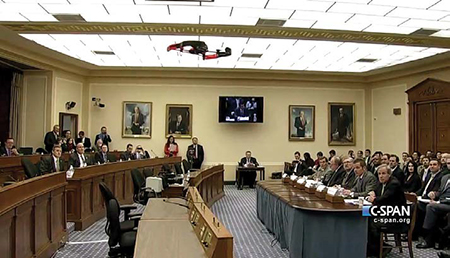What Tom Said: The Push for Drones

Tom Butts
Editor-in-Chief
tbutts@nbmedia.com Drones are literally everywhere these days, except in the skies, at least, not legally. But that’s beginning to change as early adopters and other advocates push for exemptions and faster action from federal regulators.
Although drones (or whatever they’re called these days—unmanned aerial vehicles or “systems”) have been used regularly by the military, their use in the United States is still restricted by the Federal Aviation Administration. The regulator—which had been mandated by Congress to create rules for the commercial and private use of UASs by the end of this year—has indicated that they may not be ready until 2017.
This isn’t sitting well with the companies that manufacture the systems or its potential users, some of whom appeared before a congressional subcommittee last month to push for accelerated timeline for adoption of drone regulations. “There is no denying it, the commercial drone market is here and growing faster than ever,” Jesse Kallman, the head of business development and regulatory affairs for San Francisco-based AirWare, a drone and services developer, told the legislators. Kallman warned that delayed regulations are forcing many vendors to move to other countries where the rules for covering the use of the flying wonders are already in place. The hearing even included a drone demonstration that was the “buzz” of Capitol Hill for much of the week.
The FAA is understandably concerned about safety, but technology has a way of ameliorating such concerns. One such technology discussed at the hearing, called “geofencing,” helps control the use of a drone if it loses the communications link between the “pilot” and device. “It keeps a vehicle within certain altitude and geographic regions, and contingency management systems… enable the vehicle to safely land when an issue such as loss of communications arises,” Kallman told the subcommittee.
Then there are also concerns about privacy rights; however, many of those can be addressed with current rules. As Mike Cavender, executive director of the Radio Television Digital News Association, told me several years ago when I wrote about the subject, the rules should be similar to any other that applies when the right to privacy is involved. “What’s your motivation for obtaining the information?” he mused. “Ultimately this is an editorial question and it doesn’t matter whether you’re using a camera in a briefcase, a lapel pin or a drone.”

Members and staff of a congressional subcommittee watch on as a drone is demonstrated at a recent hearing on Capitol Hill. With the FAA under pressure, states are taking the matter into their own hands, with some considering banning the devices for hunting; other groups—including a recent inter-faith gathering at Princeton University—have debated the moral implications of the use of drones in warfare. Last month, a drone carrying several pounds of methamphetamine crashed in a parking lot in a California border town; and a small drone was found on the grounds of the White House. These were reminders of the technology’s double-edged nature.
For media, the use of drones could have a huge impact—on budgets, scope of coverage and improved safety. We’ve already discussed the potential of using drones for such daily tasks as traffic reports, but what about tower inspections or other uses for managing facilities or land? When it comes to emergencies, broadcasters are already, in some ways, considered “first responders” (or, less contentiously, “first informers”); the use of drones could greatly enhance how emergency crews—and the public—gather crucial information. It’s this potential that led to last month’s announcement of a joint public-private partnership between Virginia Tech and some of the country’s largest media companies to test drone use in ENG environments (see “Media Groups to Test Drones With Virginia Tech.”)
The professional video industry's #1 source for news, trends and product and tech information. Sign up below.
When it comes to entertainment, drones are a no-brainer. Last fall, the FAA approved six drone companies to provide commercial services for motion picture and television companies. The FAA’s decision prompted ESPN to petition for approval—which it got just days before the event—to use drones to cover the extreme sports action at last month’s Winter X-Games, the first time the devices have been used at a live sporting event in the United States. As for amateur drone projects, a quick search on YouTube yields more than 825,000 videos.
The interest in drones doesn’t appear likely to wane anytime soon. TV Technology recently posted a link to a YouTube video of a technician changing a light bulb on top of a 1,500-foot TV tower. The producers employed a drone to provide striking new perspectives on the job of a tower climber; it was one of the most popular stories on our site, and the YouTube original had more than 1.8 million hits at last check. It also caught the attention of the FAA, which notified the company involved— Prairie Aerial of Sioux Falls, S.D.— to “cease operations.”
While the use of drones is severely restricted in this country, you can obtain a UAS, for as little as $50 to as much as $3,000; perhaps you even received one as a Christmas present. For those who do break the rules, the FAA is watching and will not hesitate to crack down. For more information on current drone rules, visit https://www.faa.gov/uas/
In the meantime, we’ll be watching as developments unfold, both in the halls of Washington and the skies above.
As part of an ongoing campaign between the RTDNA and the NAB to gain a limited exemption for newsgathering purposes, the RTDNA is seeking examples from the news media on how drones could have been used in a certain situations. If you have an example you want to share, send it to Mike Cavender atmikec@rtdna.org.
Tom has covered the broadcast technology market for the past 25 years, including three years handling member communications for the National Association of Broadcasters followed by a year as editor of Video Technology News and DTV Business executive newsletters for Phillips Publishing. In 1999 he launched digitalbroadcasting.com for internet B2B portal Verticalnet. He is also a charter member of the CTA's Academy of Digital TV Pioneers. Since 2001, he has been editor-in-chief of TV Tech (www.tvtech.com), the leading source of news and information on broadcast and related media technology and is a frequent contributor and moderator to the brand’s Tech Leadership events.

